

Libraries as Creatures of Copyright:Why Librarians Care about Intellectual Property Law and Policy. Know Your Copyrights. Copyright Timeline: A History of Copyright in the United States. 18th-19th Centuries | 20th-21st Centuries | Bibliography and Resources.
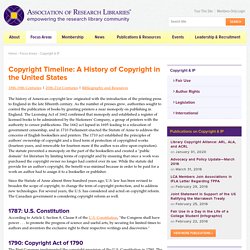
Copyright Term and the Public Domain in the US. Copyright in Education Infographic. Fair Use Evaluator. The Copyright Genie. Educational Exemptions in the U.S. Copyright Code. The U.S.
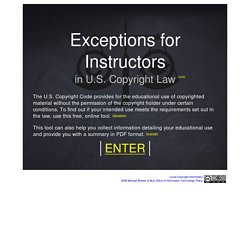
Copyright Code provides for the educational use of copyrighted material without the permission of the copyright holder under certain conditions. To find out if your intended use meets the requirements set out in the law, use this free, online tool. [disclaimer] This tool can also help you collect information detailing your educational use and provide you with a summary in PDF format. [example] This tool is valid for those uses that meet the requirements and which take place within the United States. THIS TOOL IS:Intended as a source of information for educators & others to better understand the educational exemptions available in the U.S.
THIS TOOL IS NOT: A source of legal advice. A legal copy is one that was legally obtained (purchased from a reputable vendor, checked out from a library, etc.). Harvard Library Copyright and Fair Use Tool. Plagiarism Tutorial. What Is Plagiarism?
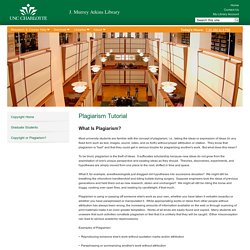
Most university students are familiar with the concept of plagiarism, i.e., taking the ideas or expression of ideas (in any fixed form such as text, images, sound, video, and so forth) without proper attribution or citation. They know that plagiarism is "bad" and that they could get in serious trouble for plagiarizing another's work. But what does this mean? To be blunt, plagiarism is the theft of ideas. It suffocates scholarship because new ideas do not grow from the assimilation of one's unique perspective and existing ideas as they should. What if, for example, anesthesiologists just dragged old hypotheses into successive decades? Plagiarism is using or passing off someone else's work as your own, whether you have taken it verbatim (exactly) or whether you have paraphrased or manipulated it.
Examples of Plagiarism: • Reproducing someone else's work without quotation marks and/or attribution. Digital Copyright Slider. DMCA: The Digital Millennium Copyright Act. Introduction On October 12, 1998, Congress passed the Digital Millennium Copyright Act (DMCA).
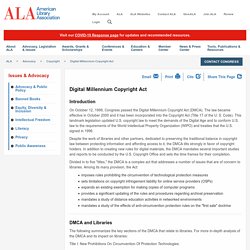
The law became effective in October 2000 and it has been incorporated into the Copyright Act (Title 17 of the U. S. Code). This landmark legislation updated U.S. copyright law to meet the demands of the Digital Age and to conform U.S. law to the requirements of the World Intellectual Property Organization (WIPO) and treaties that the U.S. signed in 1996. DMCA: The Digital Millennium Copyright Act in Detail. University of Minnesota Libraries · University of Minnesota Libraries. Who Owns The Rights To Your Scholarship?
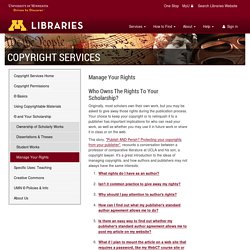
Originally, most scholars own their own work, but you may be asked to give away those rights during the publication process. Your choice to keep your copyright or to relinquish it to a publisher has important implications for who can read your work, as well as whether you may use it in future work or share it in class or on the web. This story, "Publish AND Perish? Protecting your copyrights from your publisher", recounts a conversation between a professor of comparative literature at UCLA and his son, a copyright lawyer. Responsibly Managing Your Own Copyrights. Responsibly Managing Your Own Copyrights Although every one of us is a copyright holder, (recall copyright protection arises automatically as soon as an original work is fixed in a tangible medium of expression), the majority of us do not create copyrighted works that are publishable or convey information in demand.
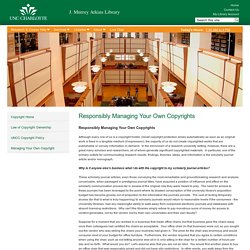
In the microcosm of a research university setting, however, there are a great many scholars and researchers, all of whom generate significant copyrighted materials. In particular, one of the primary outlets for communicating research results, findings, theories, ideas, and information is the scholarly journal article and/or monograph. Why is it anyone else's business what I do with the copyright to my scholarly journal articles? Suppose for a moment that you worked in a business that made office chairs, but that business gave the chairs away once their colleagues had certified the chairs as acceptable. What does this have to do with copyright? Everything. 17 U.S. Code § 106 - Exclusive rights in copyrighted works. House report no. 94–1476 General Scope of Copyright.

The five fundamental rights that the bill gives to copyright owners—the exclusive rights of reproduction, adaptation, publication, performance, and display—are stated generally in section 106. These exclusive rights, which comprise the so-called “bundle of rights” that is a copyright, are cumulative and may overlap in some cases. What Can I Use in Classes? Faculty and students have a compelling and immediate need for accurate information about what works they may or may not use in their courses, whether the class meets in person and/or online.
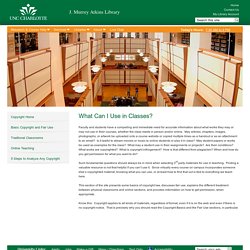
May articles, chapters, images, photographs, or artwork be uploaded onto a course website or copied multiple times as a handout or as an attachment to an email? Is it lawful to stream movies or music to online students or play it in class? The Educator’s Guide to Copyright, Fair Use, and Creative Commons – The Edublogger.
Lately, we’ve been hearing more and more about digital copyrights and fair use in the news and online – particularly with the whole SOPA/PIPA uproar that recently swept the web.
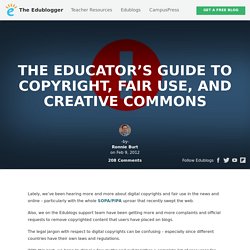
Also, we on the Edublogs support team have been getting more and more complaints and official requests to remove copyrighted content that users have placed on blogs. The legal jargon with respect to digital copyrights can be confusing – especially since different countries have their own laws and regulations. With this post, we hope to dispel a few myths and pull together a complete list of resources for teachers and students to use when blogging and working with content online. Rule #1: You Can’t Use Everything You Find On the Web This may seem obvious, but judging by the notices we have received, many teachers (and especially students) are under the impression that if it is on the web, then it is up for grabs. If you and your students keep rule #1 in mind, then everything else should be fine. Understanding Fair Use.